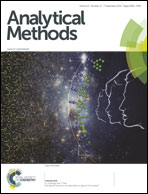Label-free and sensitive electrochemiluminescence aptasensor for the determination of 17β-estradiol based on a competitive assay with cDNA amplification
Abstract
A label-free competitive electrochemiluminescence (ECL) aptasensor for the determination of 17β-estradiol (E2) was developed based on the immobilization of thiol-capped E2 aptamers onto a gold electrode. A complementary DNA (cDNA) was designed to be used as a detection probe to bind with any unbound E2 aptamer. Tris(2,2′-bipyridyl)ruthenium(II) (Ru(bpy)32+) was used as an ECL indicator and was electrostatically bound to the E2 aptamer; it competes with the cDNA for aptamer binding sites. With less E2, increased amounts of cDNA can bind to the E2 aptamer and adsorb more Ru(bpy)32+, greatly enhancing the ECL intensity. With more E2, the aptamer will capture E2 and bind less cDNA with an accompanying decrease in Ru(bpy)32+ and a decrease in ECL intensity. Thus, a competitive aptasensor based on the specific binding of the E2 aptamer to E2 and cDNA was achieved. The biosensor for E2 possesses a widely linear detection range from 0.01 to 10 nmol L−1 with a detection limit of 1.1 × 10−12 mol L−1 (S/N = 3). The application of the present protocol was demonstrated by determining E2 in human serum, human urine, and tap water samples with recoveries of 89.8–100.0%, 90.0–103.5% and 89.5–95.0%, respectively. The proposed method provides a powerful tool for the rapid and sensitive detection of small molecules in biological and environmental samples.


 Please wait while we load your content...
Please wait while we load your content...